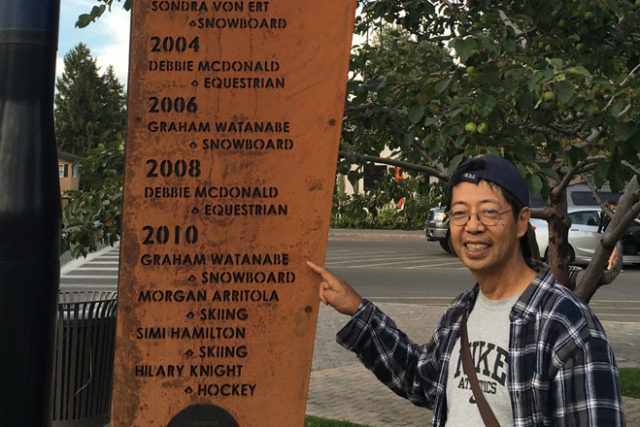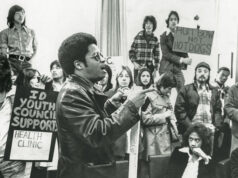By David Yamaguchi
ON SEPT. 7, I shared the story of my drive with three friends to see the solar eclipse in Sun Valley, Idaho. Today, I pick up where I left off, starting with the morning of Aug. 21.
ON ECLIPSE MORNING, I was the first out of bed, as I had opened my Venetian blinds so the light would gently wake me and I wouldn’t oversleep. I felt like a child on Christmas Day! Nonetheless, all were soon awake as well, perhaps from hearing me move about.
Gathering back at Stella’s as the start of the eclipse approached—scheduled for 10:11 at the western state border and crossing the state in the next five minutes—we soon shared our delight with the moon taking an ever larger bite out of the sun. We also took in the spectacle of countless inverted sun crescents dancing on the ground beneath a nearby quaking aspen tree. As had been described in the prior Tuesday’s Science section of the New York Times, the leaves in a tree’s canopy act like a pinhole camera to create spots of light on the forest floor.
The very best early-eclipse “parlor trick” images came from a colander, which Stella produced on request from her kitchen. The multiple crescents it produced, projected onto an outside table, were enhanced by the perfect spacing and alignment of the holes. A small army of partial suns marched in formation across the tabletop.
Of the early phases of the eclipse, what I found surprising is how bright the landscape remained until just before totality. Until then, it appeared only that something was wrong with the sun. Like a winter sun, it began to lack brightness and warmth.
Additionally, I found it remarkable how quickly the landscape chilled as the sun began to disappear. We were just over 5900 feet above sea level. I was glad that I had stuffed a light down jacket into my rucksack last-minute. I fished it out and put it on, feeling guilty for the seconds it took from witnessing the spectacle forming in the sky above me.
AS TOTALITY STARTED, I reminded myself not to remove my shade-14 eclipse goggles (which I had purchased eight months before, as Christmas stocking stuffers and for myself). For even though I had read that it is safe to do so “at totality,” I had feared for my eyes.
Nonetheless, when the long- anticipated minute and 40 seconds of abrupt darkness arrived, my opaque glasses went black. I had to remove them to see anything at all.
Glancing up then, I was astonished to see the most amazing sight I have seen in my entire life: the sun reduced to an eerily glowing thin ring in an inky sky! Transfixed—for what must have been tens of seconds—I next watched a pink glow appear at “four o’clock” on the ring. I recognized this as the first rays of a second dawn bending their way around the moon.
While I had seen many a total-eclipse image in the media during the preceding weeks, words fail in describing how unimaginably magical and beautiful an eclipse is to see with your own eyes. Who knew!?!?
All of those present, perhaps even the “it’s all about me” teenager in attendance, were frozen by the spectacle. We were thunderstruck.
And then—all too soon—it was over. Only then did we grasp the significance of not being nearer to the centerline of the path of totality, 30 miles distant. For only along that line does an eclipse linger the longest. All of us would have gladly stared in awe at the wondrous ring for another 30 seconds. Still, in getting as close as we did as first-time eclipse chasers, we had done well enough.
That we had made it there at all had been a minor miracle in itself. For throughout our planning, we had felt that at least three drivers would be essential to making our trip possible in a manageable period of time. Yet, all of my travel-mates have elderly parents, whose well-being is always in their minds….
Moreover, as late as the previous Tuesday, I also had second thoughts about whether making the trip would be worthwhile. It had been the New York Times coverage that had lit the fire beneath me that we were doing the right thing.
AFTER VIEWING THE ECLIPSE—and a leisurely brunch with our host, Stella—there was time to see something of the town of Sun Valley. To begin, it is formally known as Ketchum to locals and on many maps. They reserve “Sun Valley” for the adjoining ski resort. So after helping Stella with the dishes and extra guest chairs, we set out to see what there was. She instructed us to start at the “Gold Mine,” a thrift shop where unwanted items left by the rich end up after weekend stays.
Like many an interior ski town, Ketchum is peopled nearly exclusively with members of the Caucasian tribe. It is as if they are seeking the cold, mountainous environments of their ancient roots. On our approach to Ketchum, watching two private jets land at the local airport had provided our first clue to the kind of community we would be lodging in. It explained the ethnic composition before us.
The immense mansions in the neighborhood surrounding the condo complex we were staying in added to those first impressions. So did their prices in the window of a Sotheby’s realty office downtown. The listings resemble those of Seattle homes, but differ in that most have an additional leading digit that isn’t always a “one.” The comment of one of my travel-mates on these houses: isn’t the purpose of a vacation home to spend time with family? If so, how much time is a family actually together in a huge house?
As a Beacon Hill Boy, it struck me as especially odd that I did not see a single African American during my day and a half in the area.
By contrast, the town and its environs share a deep Asian-American past. For one, the former Minidoka internment camp lies 81 miles due south. From that base, residents had forayed out into the countryside on farm labor and irrigation projects, including that of Anderson Ranch Dam, along our route. Farther back in time, the Chinese had been among those who worked the silver and lead mines that funded the region’s early days, according to Stella and one local museum. Below the adjoining town of Hailey, she said the openings to several mines are still visible in the basements of town businesses, where they have been boarded up by owners.
As described by Iris Chang in “The Chinese in America,” the region’s mining past was the post-“Golden Spike” (1869) era, when thousands of California “Celestial” railroad workers were let go in Utah on the spot. They accordingly began walking the earth in search of other employment.
This is what put them into conflict with the Whites for mainstream jobs on a large scale for the first time. It is what led to the Chinese Exclusion Act, and to white America seeking another immigrant group who would continue the hard work of building the country. The ideal would be a people who would work as hard as the Chinese for as little, but were not as savvy….
Besides those early Chinese- and Japanese-American influences, here and there I found modest present-day JA imprints on the town as well. In the milling downtown crowd, there were a few unmistakably JA faces beyond the three of ours. Further, in the downtown park near the grocery, the name “Graham Watanabe” is immortalized on a metal signboard as a two-time Olympian snowboarder. Moreover, in a nearby mall, a poster advertises the work of local artist, Mark Kashino. His fine-art paintings include the visages of Native Americans.
THE NEXT NORTH AMERICAN SOLAR ECLIPSE is in April 2024, less than seven years away. More distant from Seattle than the 2017 eclipse, I nonetheless highly recommend adding it to your bucket list.
P.S. Full disclosure: after the trip, my eyes felt as I remembered they did after mountain climbing on bright Mount Rainier in my youth. That feeling of “tired eyes” took a full two weeks to resolve. Still, if I had a chance to see another eclipse next month, I would, albeit with a better pair of eclipse glasses.







